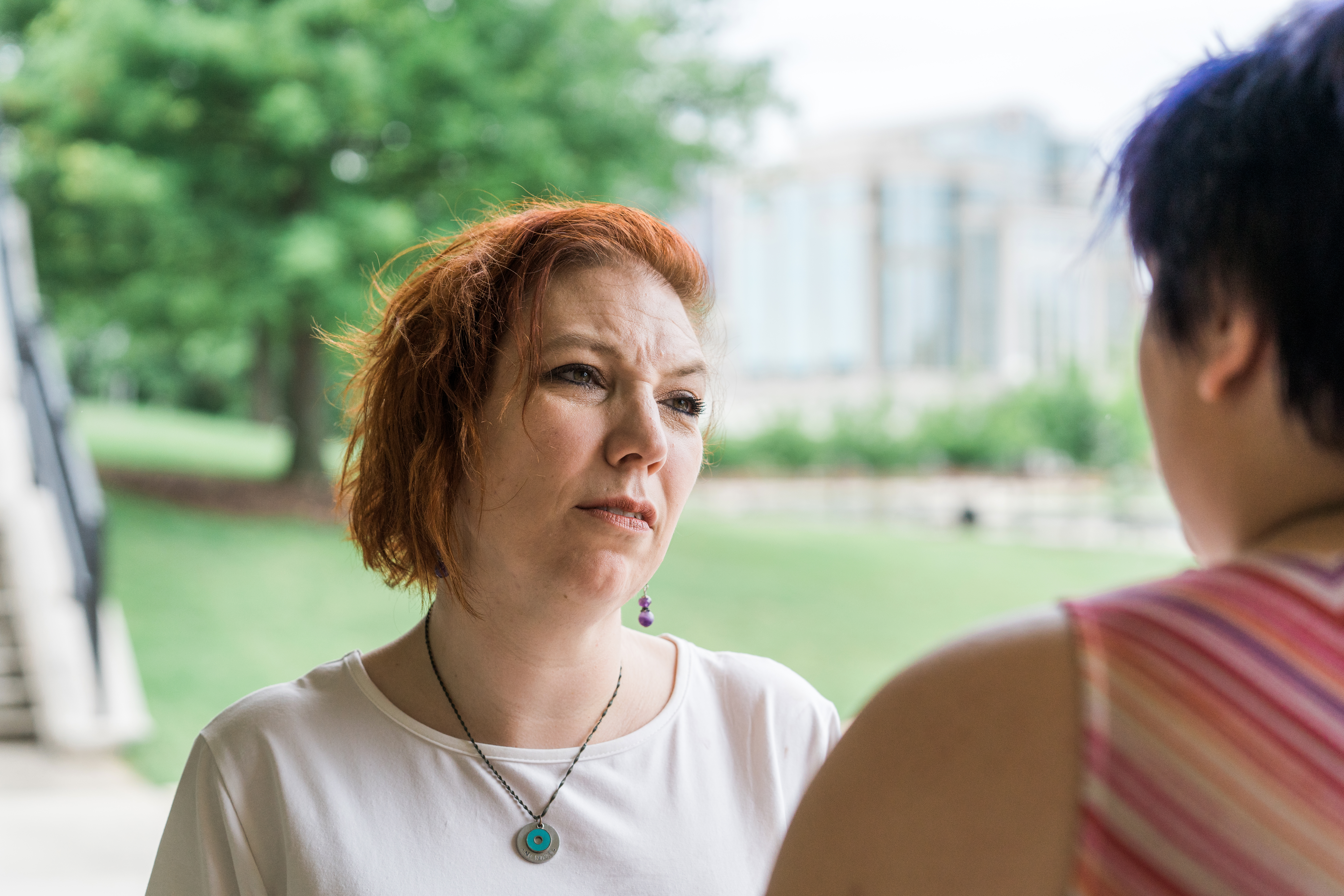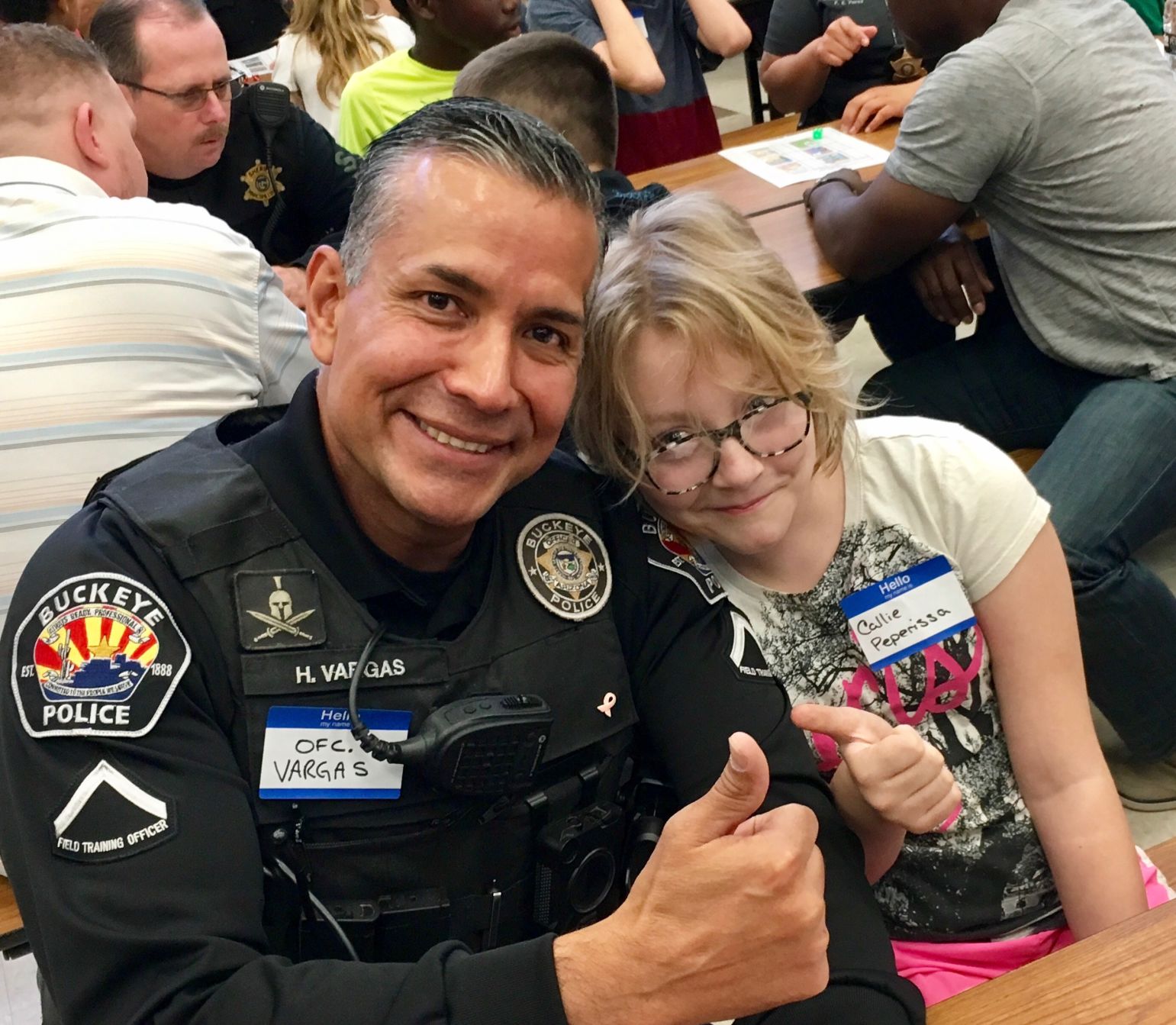
Why police need training to interact with people on the spectrum
Encounters between law enforcement and people with autism often go wrong, but some police departments are beginning to train their officers.
J
ohanna Verburg admits she wasn’t on her “best behavior” the day she was arrested. It was a chilly morning in March in Sheffield, Alabama, near where Verburg lives. She was waiting for her 11-year-old daughter to finish a therapy session when she got into an argument with another woman in the waiting area of the therapist’s office. As the argument escalated, the office manager called the police.Verburg, 41, had been diagnosed with autism a month earlier. As a nurse practitioner, she was familiar with the condition, and recognized that she has some autism traits. When she’s nervous, for example, she stretches her fingers, cracks her jaw and plays with her rings — a form of ‘stimming,’ or self-stimulation, that keeps her calm. And when she’s around authority figures, such as the police, she says, she starts “shutting down” and has trouble communicating.
When the officers arrived and followed her out of the therapist’s office, she paused on the sidewalk to write a note to her daughter. It seemed reasonable to leave a note about why she’d left, Verburg says. But the police shouted at her to keep moving. “I said, ‘Okay, I have autism spectrum disorder. I do not understand what you’re saying; I need you to explain that to me.’”
The next thing she remembers is one of the officers pulling her arms behind her back and putting handcuffs on her wrists. “He became exponentially more aggressive the moment I identified as autistic, which startled me,” she says. (The police report does not state that she disclosed her diagnosis.) Verburg says she recalls the officer saying, “I’m done explaining anything, we’re going in.”
Connor Leibel’s near-arrest in July 2017, which was widely publicized in the U.S. media, also escalated within a matter of minutes. Connor, who was 14 at the time, has autism and the intellectual ability of a 6-year-old. He was flicking and staring at a piece of string when a police officer approached him in a park in Buckeye, Arizona. A few minutes later, a family friend looking after Connor that day returned to the park to find the officer holding down the teenager’s lanky frame on the ground. In footage captured by the officer’s body camera, Connor tells the officer he is stimming; but later, the officer tells the family friend he thinks Connor has taken drugs. Connor was not charged, but he left the scene bruised and bleeding, with an ankle injury that required surgery six months later, his parents say. The Buckeye Police Department declined to comment on the incident.
An encounter with the police also turned violent for Reginald Latson, a young man with autism in Stafford County, Virginia. In May 2010, Latson, then 18, was waiting for the public library to open when a staff member at a neighboring elementary school called the police and reported that a crossing guard had spotted a young black man with a gun. When the responding police officer found Latson nearby and asked him to identify himself, Latson did not give his name. Latson fought with the officer and injured him, though it’s unclear how the fight began. Latson was convicted of assault, among other charges, and sentenced to two years in prison. The police never found a gun.
These stories all highlight a central predicament for people with autism: Some of the condition’s traits — from social anxiety and stimming to trouble with language and making eye contact — can resemble a police officer’s standard profile of a suspicious person. Add flashing lights, a shrill siren or the blare of a bullhorn, and it can be paralyzing for someone with autism, who may have extreme sensitivity to light, sound or touch. In the United States, many large police departments offer some form of training to help officers recognize and be sensitive to these differences. In many of those departments, however, the training is not mandated. And it doesn’t seem to be much better in other countries: A 2016 survey of 394 police officers in England and Wales found that only 37 percent had received any autism-specific training.

Just how frequently interactions between police and people with autism take place or turn violent is unknown. Few experts track rates of encounters, arrests or imprisonment of people with autism. In general, Americans with a disability are more likely to be arrested than those without. And anecdotal evidence suggests that for people with autism, this is a serious problem regardless of race, gender, age, socioeconomic status or autism severity. As in the general public, men on the spectrum who are black or Latino, and those who have a history of aggression, may be particularly at risk of encounters with the police.
Even without statistics, though, the need for better training is clear — both to coach police on how to modify their approach for people with autism, and to teach people with autism how to respond and cope in these situations.
“Most of the intervention thinking comes from the standpoint of, what do we need to do to police to educate them about autism?” says Paul Shattuck, director of the Life Course Outcomes Research Program at the A.J. Drexel Autism Institute in Philadelphia. “I think the other direction is important, too.”
”"The biggest highlight from my article is individuals with autism are being stopped often." Julianna Rava
Under the radar:
I
n the wake of several highly publicized cases of police brutality over the past decade, data scientists and media organizations have led efforts to make law enforcement more transparent. Despite this increased scrutiny, statistics on incidents specifically involving people with autism are nearly impossible to come by. Spectrum queried more than 30 of the largest law-enforcement departments in the U.S. about their reporting practices; of the 18 that responded, none track those numbers. Without that information, little is known about where, how often or why people with autism come into contact with police.In 2014, Julianna Rava set out to find some answers. Starting when she was a graduate student at Drexel University, she and her colleagues probed a national special-education database that surveys young people and their parents on a number of topics, including police interactions. “When we did the literature review, there was no nationally representative samples of this,” says Rava, now a health science policy analyst for the National Institute of Mental Health’s Office of Autism Research Coordination. “And I thought, no matter what, this could be my contribution to this topic.”
Her findings, published in February 2017, show that nearly 20 percent of young people on the spectrum have had a run-in with police by age 21, and about half of those by age 15. About 5 percent are arrested by the time they’re 21. But because there are no long-term data, there’s no way to tell whether these statistics are on the rise or declining, and how they might compare with numbers for the general population. “It’s very hard to get a straight ‘yes’ or ‘no’ [that] they’re higher than [in] the general population,” Rava says. “But I think the biggest highlight from my article is individuals with autism are being stopped often.”
She and others have identified several factors that increase the odds of an individual with autism being stopped by the police: Boys and young men with autism are more likely to have police encounters than are girls and young women with the condition. Those who have difficulty controlling their temper are also more likely to have police contact, according to a small Canadian study of people with autism. Another analysis, published in November, found that young people with autism who have visited or been admitted to a hospital for ‘serious psychiatric problems’ have a ninefold increased risk of a police encounter. That same survey also found that young people with autism from families with an income of less than $79,000 a year have double the risk of police contact as those from higher-income families.
Race didn’t turn up as a factor in Rava’s study, but it seems like “a no-brainer,” says Shattuck, one of Rava’s former advisors. “We can be ultra-conservative and say we don’t have data about that in the world of autism,” he says. “But come on, how much data do we need?”
Parents of young people with autism have come to the same conclusion. Rachel Harvey, mother of Evan, 20, says she has coached her son to follow orders should he ever meet a police officer. “Because he’s already a black man, he’s already got that one thing going against him,” says Harvey, who lives with her son in Collingswood, New Jersey, a town she describes as diverse with a “good small-town feel.” That sense of community assuages her fears that Evan will be mistaken for a criminal, she says, but she can’t completely erase her concern that one day he won’t make it home from his night shift working at McDonald’s.
Families of young people with autism also worry about misleading reports in the press that link autism diagnoses, such as those given to mass shooters Adam Lanza and Nikolas Cruz, with violent acts — and the potential bias those reports might create. In fact, there is no evidence to suggest that autism predisposes someone to violent behavior, says Matthew Lerner, assistant professor of clinical psychology at Stony Brook University in New York.
In 2012, Lerner and his colleagues described a perfect storm of autism traits — social difficulties, trouble regulating emotions and impairments in ‘theory of mind,’ or the ability to understand others’ mental states — that could hypothetically lead to isolation, impulsivity and, possibly, violence. But that same mix might also propel a typical person to violence, and there’s little research on how such a maelstrom of feelings plays out in the real world. In January 2014, Lerner appeared before the Sandy Hook Advisory Commission — convened to make recommendations to prevent murders like the ones Lanza committed in 2012 in Newtown, Connecticut. “There was essentially a day in the Sandy Hook commission where they were trying to understand, does [Lanza’s] autism play a role?” Lerner says. He testified that, in most cases, having autism would certainly not make anyone more or less prone to violence.
Some experts question whether most people with autism are even culpable in instances when they do commit crimes. “If they have autism, it affects every aspect of their life,” including the ability to judge right from wrong, says Gary Mesibov, former director of the TEACCH Autism Program at the University of North Carolina at Chapel Hill. Mesibov has testified in criminal cases involving individuals with autism for about five years. “It doesn’t necessarily mean they shouldn’t be guilty in the way it gets measured [in court],” he says, but “it’s a gray area, and it’s incredibly difficult.”
”"We have a certain amount of buy-in from officers because there's quite a number of officers that have autistic people in their family." James Purcell
Too little training:
J
ohanna Verburg is on the mild end of the spectrum, and the officer might not have known about her condition if she had not disclosed it. On the other hand, anyone who talks with Connor Leibel can tell within seconds that he isn’t neurotypical, but he has never been in trouble. His parents suspected something was wrong when he was a toddler: He walked on his toes and was delayed as he learned to speak. He lined up his yellow Lego bricks side by side instead of using them to build a structure. A clinician diagnosed him with autism when he was 2.Most nights around dinnertime, Connor pulls his parents into chats about his day at school. He has made a number of friends in his special program for adolescents with autism. He wants to interact with other people, but his conversational skills are “rudimentary,” his mother says.
After the incident in the park, the Leibels filed a formal complaint against the officer involved, but an internal police investigation cleared him of any wrongdoing. The report noted that the officer had not been trained “in handling special-needs people or mentally ill persons.” The Buckeye Police Department offers training, but, the report said, “Only certain officers in this department went to Critical Incident Training due to restricted number of available seats during the training.” (The Leibels say they are planning to sue the Buckeye Police Department for financial damages.)
Arizona does not require police training for interacting with people on the spectrum; neither does Alabama, where Verburg lives. But at least three other states — Florida, New Jersey and Pennsylvania — have mandated training for police or other first responders, such as firefighters. Even so, a 2016 study found that in New Jersey, which passed its law in 2008, 23 percent of those agencies had not complied with the law. “Potentially, thousands of police officers, firefighters and [emergency medical services] personnel who would respond to calls involving autistic individuals have not been trained to respond properly to these situations,” the researchers concluded. Almost 50 percent of the respondents who had received training said their training was only “somewhat effective or not effective.”
Of the 18 large U.S. police departments that responded to Spectrum’s queries — including some in Florida and New Jersey —15 say they offer some form of autism-specific training, but these programs vary considerably. For instance, the New York City Police Department, which employs more than 36,000 uniformed officers, says every in-service officer receives training each year to help them recognize autism traits. In Harris County, Texas — which includes the city of Houston — all 2,249 sworn officers are required to attend a one- to three-hour presentation on signs of autism. The training also includes response strategies: Be patient, speak calmly and don’t touch the person or stop their repetitive motions unless it’s necessary for safety reasons. The representatives of three departments in New York, Georgia and Arizona told Spectrum these tactics are woven into basic training or broader crisis-intervention courses.

The U.S. Department of Justice has compelled some city police to revise their autism training. For example, in 2012, the mayor of Cleveland, Ohio, asked the federal department to investigate its police officers’ use of force. A 2015 settlement between the federal department and the Cleveland police mandated a suite of changes, including a 40-hour crisis-intervention program with a unit on autism. Officers participate in a role-playing scenario to learn how to interact with people who have severe autism, says Captain James Purcell, the division’s crisis intervention coordinator. “We have a certain amount of buy-in from officers because there’s quite a number of officers that have either autistic people in their family or autistic children,” he says. But even this training is not enough, he says. “You could put them in [training] for six months and they still might not get everything they need.”
Training for autism is particularly complicated because of the condition’s heterogeneity. “We can’t teach police, ‘Well, because you interacted or saw this video about this one person with this presentation of autism, now you know autism and you’d be able to spot it anywhere,’” says Yona Lunsky, professor of psychiatry at the University of Toronto. Lunsky led the Canadian study linking aggression and police contact in people with autism. She says researchers need to continue to study these interactions and encourage police departments to be vigilant about training.
There are small but encouraging steps toward greater understanding between police and the communities they serve. Last year, the state of Illinois introduced a free disability identification card for people 16 and older with autism or other conditions, such as schizophrenia; the card is intended to alert police officers. “The key is to have first responders understand that not everybody behaves in the same manner under a highly stressful situation,” says Stephanie Kifowit, the state representative who sponsored the law that created the program. Many departments, including the one in Buckeye, have launched a voluntary registry for people with autism or other conditions.
“It’s heartwarming, because it gives you some kind of feeling that something good will come out of this,” says Danielle Leibel, Connor’s mother. She says things are slowly improving for Connor at home. She and her husband don’t talk about the incident in front of their children anymore, and when Connor brings it up, they reiterate that most police officers are respectful and kind. She often reminds Connor to never hit or run away from an officer. Sometimes she pretends to be a police officer herself and surprises him with a stern, “Hey! What are you doing?” Most of the time, Connor responds just the way she’s taught him to. “My name is Connor,” he says. “I have autism.”
Verburg is less optimistic. After her arrest in March, she was charged with disorderly conduct and other offenses. She was held for three hours before being released, and faces her first court date in June.
Verburg has eight children, two of whom are on the spectrum, and says she doesn’t know what to tell them about interacting with the police. “I honestly don’t have an answer to that,” she says. “I haven’t even begun to figure out how to move forward again, both personally and as a mother.”
Recommended reading

Too much or too little brain synchrony may underlie autism subtypes

Developmental delay patterns differ with diagnosis; and more

Split gene therapy delivers promise in mice modeling Dravet syndrome
Explore more from The Transmitter

During decision-making, brain shows multiple distinct subtypes of activity

Basic pain research ‘is not working’: Q&A with Steven Prescott and Stéphanie Ratté
